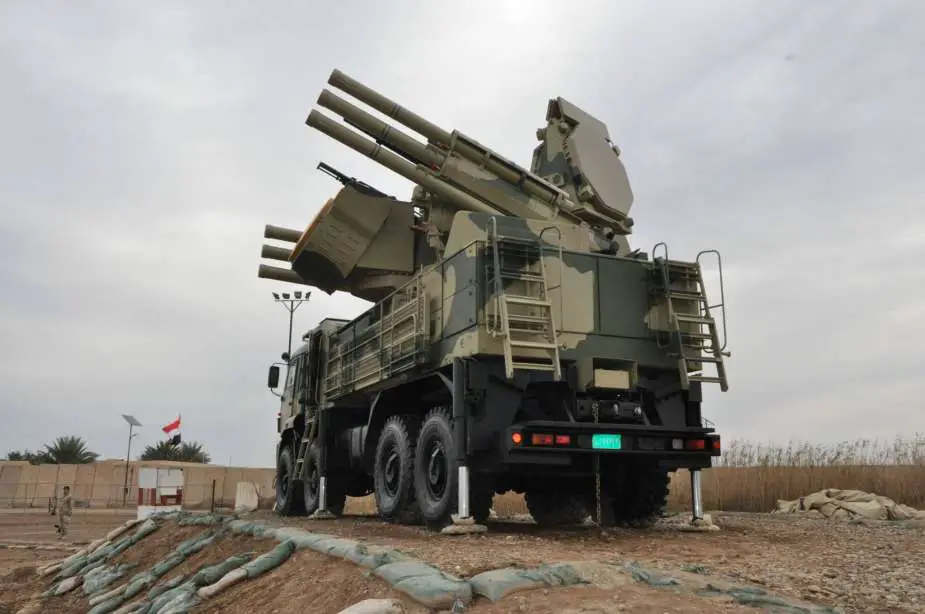Breaking news
Iraq to purchase modern air defense systems amid heightened regional tensions.
As reported by The Defense Post on March 20, 2024, Iraq is currently evaluating its options for acquiring new anti-aircraft weapons to enhance its air defense capabilities, as outlined by spokesperson Major General Yehia Rasool. The country has initiated discussions with various nations, although the details regarding potential vendors and the allocated budget remain undisclosed.
Follow Army Recognition on Google News at this link

The Iraqi Armed Forces use the Pantsir-S1 system for both short to medium-range air defense, as it combines missile and gun capabilities. (Picture source: Russian media)
This initiative is in response to increasing regional threats, and the procurement aligns with Iraq's recent acquisition of French radars. Major General Rasool mentioned that these new anti-aircraft systems would be integrated with the country’s existing radar systems, which span low, medium, and high ranges, to form a more cohesive air defense network.
As of 2023, the Iraqi Air Defense Command maintained an operational force of 5,000 personnel. Its structure is composed of distinct units, each specializing in various air defense roles. There is one Surface-to-Air Missile (SAM) battalion that operates Russian Pantsir-S1 systems, another battalion equipped with American AN/TWQ-1 Avenger systems, and a third battalion that uses upgraded Soviet Igla-S systems. Additionally, the command includes an Anti-Aircraft Artillery (ADA) battalion utilizing ZU-23-2 and S-60 anti-aircraft guns, aimed at addressing different aerial threat levels with a combination of missile and artillery systems.
In terms of equipment, the Iraqi Air Defense Command deploys multiple systems designed for specific defensive tasks against aerial targets. The AN/TWQ-1 Avenger and 9K338 Igla-S systems serve as point-defense solutions, whereas the 96K6 Pantsir-S1 units are employed for both short to medium-range air defense, combining missile and gun capabilities. For direct anti-aircraft artillery, the command utilizes Soviet-era 23mm ZU-23-2 and 57mm S-60 towed guns.
The push for upgraded air defenses was further outlined on July 27, 2022, by Iraqi Defense Minister Juma Inad, who announced the expected arrival of radar systems from France and the United States. These systems include the Thales system from France and the TPS-77 radar system from Lockheed Martin in the US. While the specific capabilities of these systems were not detailed, they are part of Iraq’s strategy to improve the detection and interception of aerial threats across its territory.
The search for up-to-date air defense systems comes in response to the outdated state of Iraq's current air defense infrastructure, which comprises systems from the 1960s and 70s. The objective of this overhaul is to address contemporary threats posed by drones, missiles, and artillery shells, particularly those launched by terrorist groups. Furthermore, the country's parliament has allocated an unspecified amount of funding for these defense initiatives, and in practice, part of this effort has seen the deployment of long-range radar systems in strategic locations within Iraq.
As reported by Army Recognition on December 21, 2023, the US Congress enacted the National Defense Authorization Act (NDAA) for the year 2024, which includes measures aimed at enhancing the air defense capabilities of Iraqi security forces and the Kurdish Peshmerga. The plan is expected to outline the necessary provisions and training for the effective employment of air defense systems by the Iraqi and Kurdish forces, with a projected implementation timeframe within 90 days after the plan is established.
It is suggested that the air defense systems, which have not been disclosed, are unlikely to be as sophisticated as the Patriot surface-to-air missile systems, focusing instead on equipment that can be deployed more readily and is suited to the specific threats encountered by the forces in Iraq and the Kurdistan region. Potential inclusions could be short-range anti-aircraft systems and portable missile defenses, primarily aimed at neutralizing drone and rocket threats.
Recent incidents have underscored the urgency of these upgrades, as Iraq's airspace faces increased vulnerability from external threats, notably from neighboring Iran and Türkiye. Recently, Iran has moved its Karrar main battle tanks towards the border area close to Iraq's Khuzestan Province, which could be interpreted as a display of military readiness, potentially affecting Iraqi sovereignty. Additionally, on January 16, 2024, an Iranian ballistic missile struck a residence in Iraq's Kurdistan region, resulting in civilian casualties.
The situation is also complicated by the escalated drone attacks on US bases in Iraq and Syria, attributed to rising regional tensions. On October 30, 2023, the US Department of Defense noted a significant increase in such incidents, with a total of 23 attacks reported in two weeks, leading to injuries among US personnel. These attacks, which intensified after the US reiterated its support for Israel, have affected Iraq's security and sovereignty. Despite defensive measures, the frequency and sophistication of these attacks challenge existing air defense systems, prompting calls for enhanced protective measures.
Finally, Türkiye's military actions against the PKK, designated as a terrorist organization by multiple entities, have further heightened tensions. Following the deaths of Turkish soldiers, Ankara launched retaliatory strikes in January 2024 against PKK positions in northern Iraq to address perceived threats. These ongoing operations contribute to security challenges in Iraq's northern regions, adding to the overall aerial threat landscape. Amid these regional complexities, the Iraqi government is considering reducing the foreign military presence to prevent its territory from being drawn into broader regional conflicts.

























